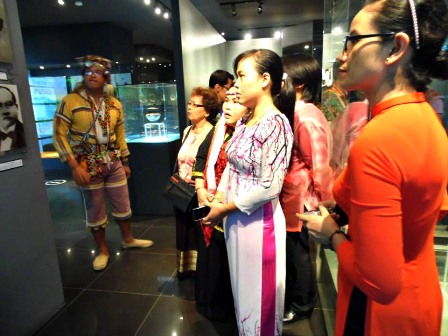Text by Stephen Pedroza
Photos by Colleen Caryl Leslie Torres of XU KKP-SIO and Jechris Abcede

Students of IFFAsia visit XU's Museo de Oro
The International Museum Month (IMM) is celebrated every May, and in the Philippines’ first folkloric museum, XU’s Museo de Oro, the occasion drew together guests from across Southeast Asia.
Nineteen students and three faculty members visited Museo de Oro on May 25 (however, the Int’l Museum Day is being celebrated every May 18) as part of a leadership program initiated by the Institute of Formation Fondacio Asia (IFFAsia), an NGO collaborating with Xavier University for research and development courses.
“These students come from different countries and they are here to be exposed to our culture and at the same time share their own,” said Luther Labitad, the group coordinator.
The students from Malaysia, Vietnam, Brunei, China, Myanmar and the Philippines toured the newly-renovated Ethnohistory Exhibit where artifacts dating as far back as the Stone Age are displayed.
The exhibit also houses various vestiges of prehistoric life dug from the Huluga Cave and other archaeological sites in Mindanao, relics collected during the Spanish, Japanese and American colonial periods, and the history of Cagayan de Oro City.
Dressed in traditional Tausug clothing, the group’s tour guide, socio-anthropology student JC Salon, enthralled the visitors with legends and historical accounts of the items inside the museum.
The tour also included a visit to the Art Gallery where the paintings of Bet Vamenta and Nonoy Estarte depicting the folklores of Mindanao are exhibited. These artworks were done when the two local artists were still under the guidance of the founder of the museum, the late Fr Francisco R Demetrio SJ.
The foreign students, for their part, presented traditional dances of their respective nations as part of the cultural exchange.
Tourism ties
Another reason for celebrating the IMM this year is the collaboration struck between various museums, such as the Museo, and the local tourism industry. It is noteworthy that several travel agencies in the city have begun including museum visits in the itinerary of local and foreign tourists.
“We have made linkages with the tourism industry so that tourists can visit our museums and learn and appreciate our culture and heritage,”said Dr Erlinda Burton, the curator of Museo de Oro.
For 22-year-old Karel anak Tingang, a student from Seria District, Brunei, going to a local museum is still one of the best ways to know about a place and its culture.
“I learn a lot whenever I visit a museum; I get to know different customs, artworks and legends. It’s a different feeling when you see the similarities and differences between your own culture and the culture of the Philippines,” he said.
This is Tingang’s first time in the Philippines. He observed, while eliciting a grin, that, “Aside from the physical appearance, we have quite similar old weapons, architecture and costumes.”
Another innovation to note is the establishment of community museums across the region to showcase the traditions and cultural symbols of the indigenous communities and to preserve them for the education and appreciation of the next generations.
The cradle of “enculturation”
For Dr Burton, an archaeologist and curator of Museo de Oro, studying our past— early lifestyles, social structures, beliefs, literature, among others— is pivotal in understanding our present.
“We need to try to understand our history through these artifacts because they contain stories about who we really are,” stated Dr. Burton who has worked with the famous paleoanthropologist Dr Louis Leakey of the National Geographic.
She emphasized the important role of parents in enculturation, the process whereby a person learns about his surrounding culture and imbibes the values and behavior of that culture.
“When parents begin to expose their children to our history and heritage at an early age, they will grow up with a strong cultural identity. … Appreciating Philippine museums starts at home and it will be reinforced by schools through field trips and history lessons. But the family must be the foundation.”
A remarkable upshot of this brand of socialization is proficiency in the language, morals and history of one’s culture.
“Knowing our own culture is one of those deeply-rooted values that should be inculcated at home,” Dr Burton said.